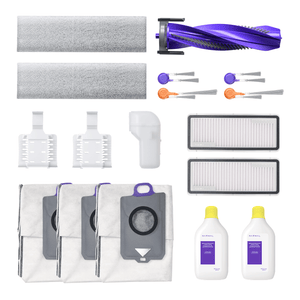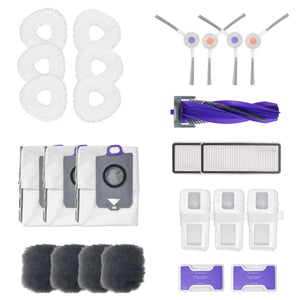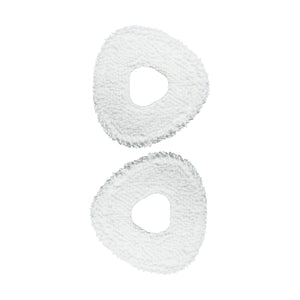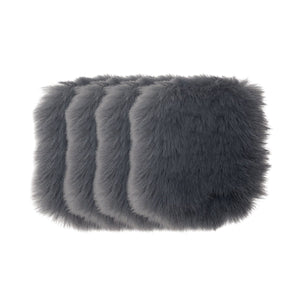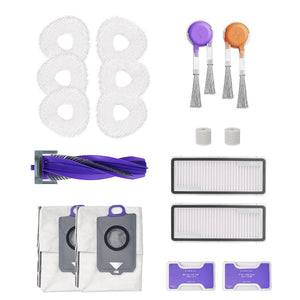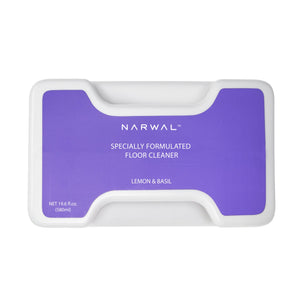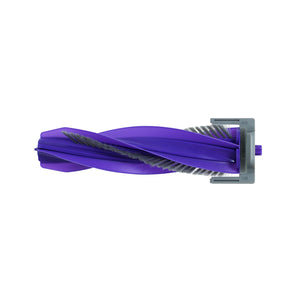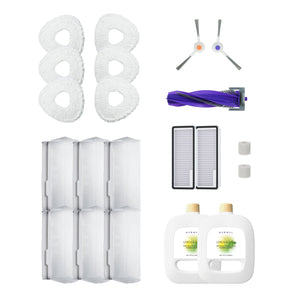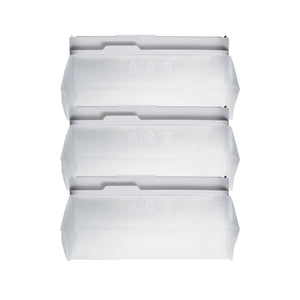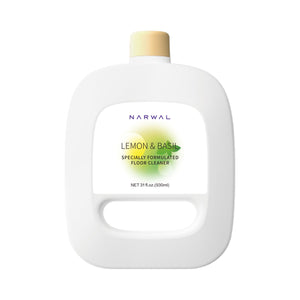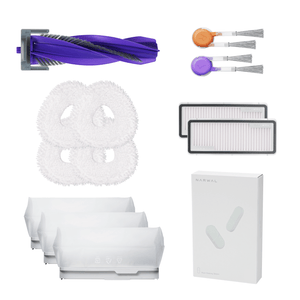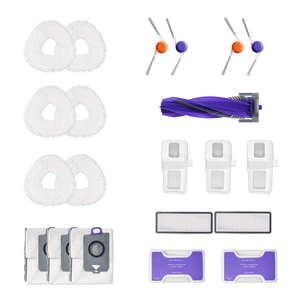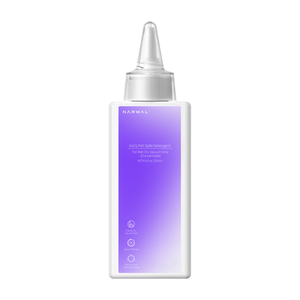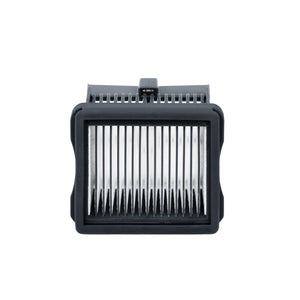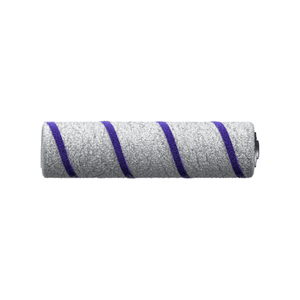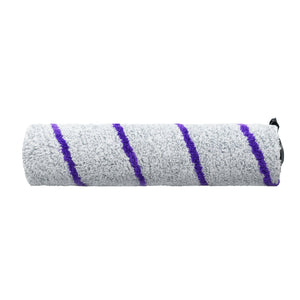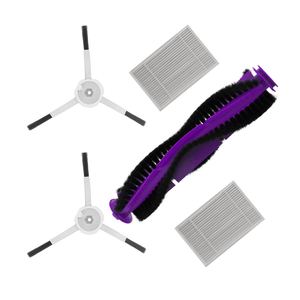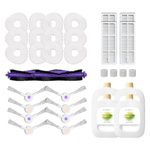Is your robot vacuum getting stuck, moving unevenly, or refusing to dock? These are all signs of dirty or jammed wheels — and you're definitely not alone.
In this guide, we’ll show you how to clean, fix, and prevent the most common robot vacuum wheel problems. Whether it’s hair-wrapped treads, wheel overload errors, or squeaky movement, we’ve got step-by-step solutions to help you get back to effortless cleaning.
Quick Fixes for Common Robot Vacuum Wheel Problems
Is your robot vacuum acting up? Before diving into detailed steps, here are some of the most common wheel issues and quick ways to address them:
-
Robot not moving or the wheels feel stuck? Check for tangled hair or debris in the main wheels and remove it carefully.
-
Seeing a “wheel overload” error? Clean the treads thoroughly and replace any wheels that look worn or damaged.
-
Is your robot spinning in circles? Try wiping down the front caster wheel and gently cleaning the wheel sensors to restore proper navigation.
-
Having trouble with docking? Make sure the docking station is clean and on a level surface, and check that the wheels are properly aligned.
-
Hearing strange noises from the wheels? Apply a bit of lubricant to the axles and inspect for wear or dirt buildup.
These quick checks can often solve the problem without needing to open up your robot vacuum. If the issue continues, the step-by-step guide below will walk you through deeper maintenance solutions.
Let’s take a closer look at how your vacuum’s wheels function and why keeping them clean is key to smooth performance.
Why Robot Vacuum Wheels Matter for Cleaning & Navigation
The vacuum wheels on your robot cleaner do far more than just roll—it’s their main job to help your robot vacuum cleaner move smoothly and detect obstacles. Clean, well-maintained wheels ensure your robot vacuum wheels perform at their best, avoiding common issues like stuck wheels or loss of navigation. Whether you have a traditional vacuum cleaner wheel or advanced models, keeping these components clean is essential for reliable performance.
Types of Robot Vacuum Wheels and Their Functions
|
Type of Wheel |
Purpose of the Wheel |
|
Main Wheels |
Typically more extensive, providing primary movement and traction |
|
Caster Wheel |
A smaller, omnidirectional wheel that aids in steering and balance |
|
Edge Wheels |
Used by some models to fine-tune movements and navigate edges and corners |
How to Clean Your Robot Vacuum’s Wheels: A Step-by-Step Guide
Keeping your robot vacuum’s wheels clean is crucial for smooth operation and efficient cleaning. Dirt, hair, and debris can easily get trapped in the wheels, causing movement issues or even damage. Here’s how to clean the Main Wheels, Caster Wheel, and Edge Wheels in detail:
Preparation Steps
-
Turn Off and Flip the Vacuum: Turn off your robot vacuum and place it upside down on a soft surface, like a towel.
-
Gather Tools: Prepare a soft cloth, tweezers, a small brush, and optionally, compressed air.
Cleaning the Main Wheels
The main wheels are responsible for driving your robot vacuum across the floor. Over time, they can accumulate dirt, hair, and debris, which can affect their performance.
Step 1: Inspect the Main Wheels: Check the main wheels for visible dirt, hair, or debris wrapped around the axles or stuck in the wheel compartments.
Step 2: Remove Debris: Use your fingers, tweezers, or a small brush to pull out any hair or dirt from the wheels and their compartments. For stubborn debris, press down on the wheels to compress them into the chassis, then release them. Repeat this a few times to loosen trapped dirt.
Step 3: Wipe Down the Wheels: Use a soft cloth dampened with water or a mild cleaning solution to wipe the wheels and their compartments.
Cleaning the Caster Wheel
The caster wheel (front wheel) helps your robot vacuum navigate and turn smoothly. It’s particularly prone to getting tangled with hair and debris.
Step 1: Remove the Caster Wheel: Firmly grip the caster wheel and pull it straight out of its housing. No tools are needed—just a little force.
Step 2: Clean the Wheel and Axle: Remove any hair or debris wrapped around the axle. Use tweezers or a small brush for stubborn clumps. Wipe down the wheel and its housing with a soft cloth to remove dust and dirt.
Step 3: Reinstall the Caster Wheel: Push the caster wheel back into its housing until it clicks into place.

Cleaning the Edge Wheels
The edge wheels (side wheels) help your robot vacuum move along edges and corners. They can also collect dirt and debris over time.
Step 1: Inspect the Edge Wheels: Check the edge wheels for dirt, hair, or debris stuck in the wheel compartments.
Step 2: Remove Debris: Use your fingers, tweezers, or a small brush to pull out any hair or dirt from the wheels and their compartments. For hard-to-reach areas, spray compressed air into the wheel compartments to dislodge stubborn debris.
Step 3: Wipe Down the Wheels: Use a soft cloth dampened with water or a mild cleaning solution to wipe the wheels and their compartments.
Final Steps
-
Dry the Wheels and Compartments: Ensure all wheels and compartments are completely dry before turning the vacuum back on.
-
Test the Vacuum: Turn on the robot vacuum and run a quick cleaning cycle to ensure the wheels are functioning smoothly.
Common Robot Vacuum Wheel Problems and How to Fix Them
1. Fixing a Stuck or Jammed Robot Vacuum Wheel
If your robot vacuum keeps getting stuck, moves unevenly, or stops suddenly, there’s a good chance the wheels are jammed or blocked. This is one of the most common issues users face—and it's usually caused by hair, dust, or small debris getting tangled around the wheel axles.
To fix a stuck robot vacuum wheel, start by turning off the vacuum and flipping it over on a soft surface. Inspect both main wheels and the front caster for signs of buildup. Use tweezers or a brush to gently remove any tangled hair or dirt. For more stubborn cases, press and release the wheels a few times to loosen trapped debris inside the housing.
Once cleaned, wipe the wheel surfaces with a damp cloth. After reassembly, test the vacuum on a flat surface to ensure smooth movement.
If you notice your vacuum wheels making unusual noise, moving unevenly, or showing visible wear on the treads, it may be time for a replacement. Genuine Narwal replacement wheels are available through our official parts store—designed to restore smooth operation and prevent further issues.
2. Robot Vacuum Gets Stuck Frequently
This issue could indicate clogged wheels or debris obstruction.
Solution:
-
Remove the wheels as per the user manual to clear away hair, string, or other obstructions.
-
Check for lodged objects within the wheel housing and clean thoroughly.
3. Robot Vacuum Fails to Dock Properly
Problems with docking can stem from wheel alignment issues.
Solution:
-
Ensure the docking area is on a flat surface to enable smooth navigation.
-
Clean the docking station and the wheels to prevent misalignment.
4. Floor Marks from Robot Vacuum Wheels
Sometimes robot vacuum wheels may leave streaks or scratches on delicate flooring. Just like any vacuum cleaner wheel, they can accumulate grit, wear out, or harden over time. This buildup increases friction and may leave marks, especially on wood or vinyl floors.
Solution:
-
Clean wheel surfaces regularly with a damp cloth to remove grit. (works for both main and side wheels)
-
Inspect the rubber treads—replace them if they feel stiff, cracked, or uneven. You can easily find a replacement wheel for robot vacuum cleaners from the official store.
-
Avoid running the vacuum on wet floors, which can create streaks.
-
If marks persist, apply a floor-safe polish or protective coating.
Pro Tip: Even with advanced models like Narwal Flow, which minimizes debris buildup, a full manual check is still essential. For Roomba or similar models, don’t forget to clean the side wheels as well.
Robot Vacuum Wheel Overload Error: What It Means and How to Fix It
If your robot vacuum displays a "wheel overload" error, it usually means one or more of the wheels are struggling to rotate due to excess resistance. This can happen when hair, string, or dust builds up around the axle, or when the wheels are damaged or worn down.
To fix this issue, start by turning off your vacuum and flipping it over on a soft surface. Inspect all wheels—especially the main ones—for tangled debris. Carefully remove any hair or dirt using tweezers or a small brush.
Try rotating the wheels by hand. If they feel stiff or uneven, the treads might be worn or the axle partially blocked. Clean the area thoroughly and check for visible signs of wear. If needed, replace the affected wheel with a compatible part.
Still seeing the overload error after cleaning? The problem could be internal—like motor strain or a sensor issue. In that case, contact Narwal customer support for further assistance. Avoid attempting motor repairs yourself, as this may void your warranty.
Brand-Specific Wheel Issues (Shark, Roomba & Beyond)
While Narwal vacuums are engineered to reduce wheel-related errors, users of other popular brands often encounter recurring problems. Understanding these issues highlights why proper wheel maintenance is essential—and how Narwal products are designed to avoid them.
1. Shark Robot Vacuum Wheel Errors
Shark models frequently show alerts like side wheel error reset, drive wheel error 18, or require front or side wheel replacement. These malfunctions can cause the vacuum to stop mid-clean or move unevenly.
-
Quick Fixes: Power cycle or reset the vacuum, check for tangled hair or debris, and clear the wheel housing.
-
Best Practice: If the issue persists, avoid DIY motor or wheel repairs—always contact the brand’s official service center. Unauthorized fixes may cause further damage and are often excluded from warranty coverage.
2. Roomba Front Caster Wheel and Circling Issues
Roomba users sometimes report problems with the front caster wheel, which can interfere with docking and navigation. Another common complaint is when the vacuum keeps going in circles, often due to dirty wheel sensors or misalignment.
-
Quick Fixes: Remove dust and hair from the caster wheel, gently wipe the wheel sensors, and ensure the docking station is placed on a flat, obstacle-free surface.
-
Best Practice: If circling continues, seek professional service support rather than attempting complex disassembly at home.
Narwal Advantage: Narwal vacuums integrate DualFlow Tangle-Free wheels and precision navigation to minimize jamming, wheel imbalance, or circling errors. Models like the Narwal Flow push this even further, combining dual RGB cameras with AI obstacle avoidance to recognize over 200 objects and navigate smoothly in real time. This advanced design reduces wheel strain, extends service life, and ensures a seamless cleaning experience with fewer interruptions.
[cta:flow-robot-vacuum-and-mop]
How Different Robot Vacuum Brands Handle Wheel Problems
Robot vacuum wheels can encounter a range of issues—from jamming and getting tangled with hair to triggering wheel overload errors or failing to dock properly. While these problems are common across brands, how each manufacturer addresses them can vary significantly in terms of user experience, ease of maintenance, and long-term reliability.
Here’s a quick comparison of how major brands like Roomba, Shark, and Narwal typically approach wheel-related challenges:
|
Feature |
Roomba |
Shark |
Narwal |
|
Wheel error notification |
LED light patterns + user manual |
On-screen error codes + basic guidance |
Real-time app alerts + auto diagnostics |
|
Ease of cleaning and maintenance |
Requires tools to disassemble main wheels |
Some snap-off parts, but often collect hair |
Tool-free disassembly for quick cleaning |
|
Access to replacement wheels |
Through official site or third-party sellers |
Often via customer service or third-party |
Narwal official parts store with guidance |
|
Error recovery |
Manual reboot or power cycle needed |
Usually multi-step manual reset |
Built-in auto-recovery for minor wheel faults |
|
Anti-tangle wheel design |
Only in select high-end models |
Not widely available |
Standard across models (e.g., DualFlow™) |
While Roomba and Shark have been around for years, their typical response to wheel issues tends to be more reactive, requiring users to reset devices manually or search for parts independently. In contrast, Narwal focuses on minimizing disruption through intelligent design: from app-based diagnostics and tool-free wheel access to standardized anti-tangle features across its product line.
If you’ve ever struggled with wheel maintenance or error recovery on other brands, switching to a system designed for easier upkeep can make a noticeable difference in everyday cleaning.
Advanced Robot Vacuum Wheel Issues: Motors & Sensors
Wheel Motor Malfunction
If the robot vacuum wheels don't turn, there may be a motor issue.
Steps:
-
Check the wheel motor and connections for signs of damage or disconnection.
-
Consult Narwal customer support for diagnostic assistance and potential motor replacement.
Unexpected Stopping
Has your robot vacuum stopped in the middle of cleaning? Wheel sensor problems or an overheated motor may be to blame.
Solution:
-
Clean the wheel sensors to ensure they are free from debris or dust, which can cause misreadings.
-
Inspect the motor area for accumulated dirt or obstructions that could cause overheating.
-
If the vacuum motor has overheated, allow it to cool down. Scheduling shorter cleaning sessions also ensures that you don't overwork the cleaning process.
DIY Robot Vacuum Wheel Maintenance vs. When to Call Support
Taking care of your robot vacuum wheels is part of essential robot vacuum maintenance requirements. Many small issues—like dust buildup, tangled hair, or worn treads—can be fixed at home with simple DIY steps. For example, you can wipe the vacuum wheels with a damp cloth, trim away fibers with scissors, or replace a wheel for robot vacuum cleaner using compatible parts. These easy tasks fall under basic robot vacuum maintenance tips and can prevent larger problems down the road.
However, not all wheel problems should be handled on your own. If your robot vacuum shows signs of wheel motor failure, repeated overload errors, or damaged sensors, it’s better to seek professional help. For Narwal robot vacuums in particular, any internal repair should only be performed by official service staff. Attempting self-repair may cause secondary damage and will not be covered under the warranty. Always reach out to Narwal’s customer support and use genuine replacement parts for safe, long-lasting performance.
Think of it this way: cleaning, inspection, and replacing small parts = DIY; fixing motors and sensors = professional support. Setting this boundary helps your robot vacuum wheels last longer and keeps your machine running smoothly.
Robot Vacuum Wheel Maintenance Tips to Extend Lifespan
Regular Cleaning
Wipe your robot vacuum wheels regularly with a damp cloth. For tougher debris, use a small brush or toothbrush.
For example, Narwal Flow’s advanced wheel design reduces hair tangles, but regular cleaning still ensures maximum performance.
Regular Inspection
Regularly inspect the wheel treads for signs of wear or damage. Promptly replace any worn wheels to maintain optimal performance.
Avoid Long Hair and String
Regularly cleaning the vacuum area prevents long hair and string from wrapping around the wheels. Use a pair of fine scissors to trim and remove any entangled fibers.
Firmware Updates

Update your robot vacuum software. Updates often offer enhancements to navigation and wheel performance.
Special Care for Robot Vacuum Wheels: Pet Hair & Floor Transitions
Handling Pet Hair

Pet hair can quickly clog robot vacuum wheels.
Care Tips:
-
Vacuum pet areas frequently to minimize hair accumulation.
-
Clean wheels more often if you have pets that shed excessively.
Transitioning Between Surfaces
Some robot vacuums may struggle to transition between floor types.
Care Tips:
-
Use ramps or mats to ease transitions from hardwood to carpet.
-
Reconfigure room layouts to minimize sudden changes in flooring.
Robot Vacuum Wheel Maintenance Checklist (Weekly, Monthly, Bi-Annual)
To ensure your Narwal robot vacuum maintains a long lifespan with peak performance, follow this maintenance checklist:
Weekly Maintenance
Clean your vacuum wheels thoroughly every week to keep your robot running smoothly. Focus on the main wheels and front caster, as these areas collect the most hair, dust, and debris. Neglecting regular cleaning is one of the top reasons robot vacuums get stuck or show wheel-related errors like overload or uneven movement.
Use a damp cloth and a soft brush to remove buildup from the wheel treads and housing. For best results, refer to our step-by-step guide or video tutorial on how to clean vacuum wheels safely and effectively.
Check the wheel treads for wear and tear, replacing them as necessary.
Monthly Maintenance
-
Perform a deep clean of the wheel wells, using tools like small brushes to reach tight areas.
-
Lubricate the wheel axles to ensure smooth rotation.
-
Update your robot vacuum software via the Narwal app.
Bi-Annual Maintenance
-
Replace any worn wheels to maintain optimal performance.
-
Inspect the wheel motors and sensors for any signs of wear or malfunction.
-
Clean the entire vacuum thoroughly, including all sensors and movable parts.
Keep Your Robot Vacuum Wheels Running Smoothly
This post completes your comprehensive guide to cleaning and maintaining robot vacuum wheels. These steps and tips can provide seamless maintenance and an efficient cleaning experience for your Narwal robot vacuum.
Besides, regular maintenance and promptly addressing any issues will keep your Narwal robot vacuum running like new. A well-maintained vacuum will not only clean better but also last longer.
After all, Narwal's customer support team is always ready to assist if you face persistent issues.
Call to Action
For further information and detailed video tutorials on maintaining your Narwal robot vacuum wheels, visit the Narwal Support Page. You will find step-by-step guides, troubleshooting videos, and customer support contacts to assist you with any issues.
Remember to join our mailing list to receive tips and updates directly to your inbox. Also, check out our blog posts for more insightful articles on maintaining a clean home with your robot vacuum. Happy cleaning!
FAQs
How Often to Clean Robot Vacuum Wheels (Especially with Pets or Long Hair)
Consider cleaning the wheels weekly to maintain peak performance, especially if you have pets or live in an area with high foot traffic.
How to Fix Robot Vacuum That Keeps Getting Stuck or Stops Mid-Clean
Check the wheels for entangled debris or obstructions. Clean the wheel housing to ensure it is free from hair and dirt.
How to Prevent Robot Vacuum Wheel Damage from Daily Use
Frequently clean and inspect the wheels to prevent premature wear. Also, avoid using the vacuum on excessively rough surfaces.
Why Robot Vacuum Wheels Make Noise While Moving
The noise could result from debris caught in the wheels or a need for lubrication. Clean the wheel housing and apply lubricant to the wheel axles if necessary.
Can I Replace Robot Vacuum Wheels Myself? (DIY Guide)
Yes, most robot vacuum wheels can be replaced at home with basic tools. Check your user manual for the exact steps, and always use a compatible replacement wheel for your robot vacuum cleaner. For Narwal models, contact official support for guidance and genuine parts to avoid warranty issues.
What is the Best Way to Remove Hair from Robot Vacuum Wheels
Hair often wraps around main or side wheels. Use a small brush, tweezers, or scissors to remove it. For deep cleaning, wipe the wheel housing with a damp cloth. Regularly cleaning hair from robot vacuum wheels prevents wheel overload errors and keeps movement smooth.
Where to Get Genuine Replacement Wheels for Robot Vacuum Cleaners
You can find compatible replacement wheels for your Narwal robot vacuum on our official parts store. Using genuine components helps ensure smooth performance, avoids further damage, and keeps your warranty intact. Always replace wheels when the treads appear cracked, flattened, or worn out.























